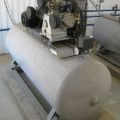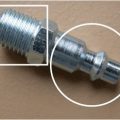Hey! This site is reader-supported and we earn commissions if you purchase products from retailers after clicking on a link from our site.
Choosing the right air compressor hose for your compressed air system can be a difficult task. With so many options, and each offering their own benefits, DIYers often turn to advice to help them come to a decision.
This article will provide you with the pros and cons of PVC, rubber, polyurethane, and hybrid air hoses, along with their suited applications and other hose selection considerations to make your decision a lot easier!
Table of Contents
- PVC Air Hose
- Rubber Air Hose
- Polyurethane Air Hose
- Hybrid Air Hose
- Hose Selection Considerations
- Frequently Asked Questions
PVC Air Hose
PVC air hoses are probably the most affordable air compressor hose available on today’s market. PVC hoses consist of a PVC-compound inner tube and a polyester spiral outer, which allows them to hold their shape. Consequently, making it difficult and possibly impossible to lie them flat.
PVC air hoses are typically stiffer than rubber hoses, making them more difficult to coil and uncoil. They tend to kink which is not desirable, and they easily become inflexible in cold weather conditions.
PVC air hoses are often distributed for free with air compressors, but because of these points, they may be difficult to work with, which is why many DIYers will upgrade their air hose to one of the following materials.
Here’s an example of a PVC air hose readily available on Amazon!
- All-purpose: Economical PVC material suitable for everyday tasks
Prices pulled from the Amazon Product Advertising API on:
Product prices and availability are accurate as of the date/time indicated and are subject to change. Any price and availability information displayed on [relevant Amazon Site(s), as applicable] at the time of purchase will apply to the purchase of this product.
PVC Air Hose Advantages
- Affordable
PVC Air Hose Disadvantages
- Stiff
- Struggle to retain flexibility in cold weather
- Tend to kink
Rubber Air Hose
Rubber air hoses are typically the most common and readily available air hoses on the market. They consist of synthetic rubber which is reinforced with either braided or spiraled yarn. These types of hoses are very durable, rarely leak, and if they do, it’s generally easy to fix.
Rubber hoses do not kink and coil so easily, which makes them very easy to work with, even when the ambient temperature is cold. Rubber hoses are typically more expensive than other types of air hoses and tend to collect a lot of direct when being dragged across the floor due to their tackiness.
Here’s an example of a rubber air hose readily available on Amazon!
- 【EXTREMELY FLEXIBLE】Giraffe air compressor hose is made of new material. All-weather flexible rubber hose (-60 to 160 ℉ Ambient) is perfect for year-round use, even in the cold winter.
Prices pulled from the Amazon Product Advertising API on:
Product prices and availability are accurate as of the date/time indicated and are subject to change. Any price and availability information displayed on [relevant Amazon Site(s), as applicable] at the time of purchase will apply to the purchase of this product.
Rubber Air Hose Advantages
- Do not kink or coil easily
- Durable
- Rarely leak
Rubber Air Hose Disadvantages
- Heavy
- More expensive than other types of hose
- Tacky materials – therefore, collect dirt
Polyurethane Air Hose
Polyurethane air hoses are often confused with PVC air hoses due to their similar appearance. The key difference between the two is that Polyurethane performs far better than PVC.
Polyurethane air hoses are lighter and more flexible than PVC, and they have a very smooth outer layer that allows them to glide across surfaces with ease. Polyurethane hoses are not as flexible as rubber hoses, which makes them susceptible to kinking. Along with this, they also have a relatively high cost among air compressor hoses.
Their qualities make them an ideal choice for working with pneumatic framing or roofing nailers, to allow both freedom of movement and weight distribution.
Here’s an example of a polyurethane air hose readily available on Amazon!
- Brass fittings never corrode and seal better aluminum, steel, iron or zinc alloy.
Prices pulled from the Amazon Product Advertising API on:
Product prices and availability are accurate as of the date/time indicated and are subject to change. Any price and availability information displayed on [relevant Amazon Site(s), as applicable] at the time of purchase will apply to the purchase of this product.
Polyurethane Air Hose Advantages
- Flexible
- Lightweight
- Smooth outer layer – ease of transportation across surfaces
Polyurethane Air Hose Disadvantages
- Not as durable as rubber
- High cost
- Likely to kink
Hybrid Air Hose
Hybrid hoses are a combination of rubber, polyurethane, and PVC. This powerful blend gives them qualities that are similar to rubber but at a lighter weight, essentially making hybrid hoses a lot easier to work with.
Hybrid hoses are very durable, lightweight, and flexible, making them perfect for all types of tasks, from being used with ladders to being used in your garage. Though hybrid hoses aren’t as tacky as rubber, and so, they don’t collect as much dirt, they are more likely to kink after extended periods of use.
Here’s an example of a hybrid air hose readily available on Amazon!
- EXTREMELY FLEXIBLE - Giraffe air compressor hose is made of new material. All-weather flexibility Hybrid hose (-60° to 160°F Ambient) is perfect for year-round use, even in the cold winter.
Prices pulled from the Amazon Product Advertising API on:
Product prices and availability are accurate as of the date/time indicated and are subject to change. Any price and availability information displayed on [relevant Amazon Site(s), as applicable] at the time of purchase will apply to the purchase of this product.
Hybrid Air Hose Advantages
- Flexible
- Lightweight
- Not tacky
- Perfect for all types of tasks
Hybrid Air Hose Disadvantages
- Likely to kink after extended periods of usage
Hose Selection Considerations
Now you have an idea of the different materials available for air hoses, I want to switch attention to the other considerations you must factor in when selecting the right air hose for you. These include:
- Coiling Capabilities
- Connections
- Hose Dimensions
- Kink Resistance
- Pressure Rating
- Temperature Compatibility
Coiling Capabilities
Air compressor hoses either coil in a standard or recoil method. Standard hoses lie flat with no coils or bends, which makes them easy to unroll and stretch flat for maximum length or for storage.
Recoil hoses are ideal for working around a garage or workshop as they have small twists in their hoses, which cause them to recoil backward when the user lets go. Standard hoses can cause tripping hazards but are the ideal choice when operating a nailer because they have a longer maximum length.
Connections
Air compressor hoses typically have threaded ends to allow users to attach quick-release connectors to them, allowing you to switch between different power tools with ease.
You must take consideration into the right-sized quick-release connector for your tools. They are generally available in 1/8″ 1/4″ and 1/2″ sizes and as aluminum or brass. Brass connectors offer better resistance to corrosion and generally are known for more air-tight connections.
Hose Dimensions
First of all, the diameter of the hoses is important to decide how much air the hose is capable of delivering. Hoses range from around 1/4″ to 1/2″ and the right one will typically depend on the size of the air compressor. The most common size air hose is a 3/8″ hose.
Air compressors with high CFM outputs (cubic feet per minute) should use a larger diameter hose while air compressors with low CFM outputs should use a smaller diameter hose. For more information on CFM, visit our guide here!
The hose length is also important in determining which applications the hose can be used for, and how much pressure it will be capable of handling. Most air hoses range from around 5 feet to 60 feet.
If you require a hose for framing, roofing, painting, or other projects that require you to be a distance from your air compressor, then you will need a lengthier air hose. But, you must be aware that the longer the hose, the greater the pressure drop.
Shorter hoses are better suited to applications like filling truck tires or any other applications that demand higher pressures with sustained use.
Kink Resistance
Air compressor hoses, just like garden hoses, are liable to twisting and kinking when pulled or uncoiled. This can cause a delay in the airflow going through the hose, and may even lead to a burst at the kink if not dealt with.
Rubber hoses resist kinking better than any other type of hose. PVC has the worst of the hoses presented in this article, while hybrid and polyurethane offer good resistance to kinking.
Pressure Rating
Each and every air compressor hose will have a maximum pressure rating, indicating the amount of pressure, PSI (pounds per square inch), the air hose can withstand before breaking.
Typically, manufacturers will recommend an operating pressure for the hose as well as the burst pressure which is the maximum pressure the hose can withstand before bursting. Keep in mind, hoses with higher pressure ratings can handle tougher jobs like inflating truck tires.
Temperature Compatibility
An air compressor’s ability to resist changes in its flexibility typically depends on the different temperatures it’s exposed to. PVC struggle in colder temperatures and become less flexible, making them harder to work with.
In contrast, rubber hoses maintain their flexibility in temperatures that reach well below freezing. Polyurethane and hybrid hoses also are able to retain their flexibility in colder temperatures.
Frequently Asked Questions
Rubber is the more durable material of the two, and it easily adapts to freezing weather, remaining flexible. PVC on the other hand is made from regular stiff plastic and is more likely to crack. Rubber is one of the lightest, most durable, and flexible hoses available.
Polyurethane hoses are very similar in appearance to PVC hoses, and they are often confused with PVC hoses, but they perform far better. Polyurethane hoses are lightweight and flexible options but typically come at a greater cost than PVC hoses, but with the greater price, you get greater quality.
A hybrid air hose is generally supposed to be the better air hose when compared to rubber because it offers all the qualities rubber does, with the addition of being lighter in weight, and less tacky. The only downfall is that hybrid air hoses are more likely to kink over time.
Polyurethane, PU, is a reinforced air hose by high tensile strength polyester. This allows it to provide a lengthier service life compared to traditional rubber, as well as weight up to 40% lighter than PVC air hoses. Polyurethane unlike PVC is capable of maintaining excellent flexibility even in freezing temperatures.
The key difference between a hybrid and rubber air hose is that hybrid air hoses combine rubber, PVC, and polyurethane to provide a more flexible, durable, and least likely to kink solution. By combining the other 3 types of hose into one hybrid, you can bring the best out of each, and any cons of one type of hose are counteracted by the pros of another. For instance, PVC can be quite rigid, but with the addition of rubber in a hybrid hose, the result is flexible.
Rubber air hoses are very easy to work with and they do not kink very easily. Hybrid air hoses are likely to kink with over extended periods of use, but offer all the benefits that rubber air hoses do while being much lighter.
Rubber hoses are the lightest and most flexible material of hoses available. They boast excellent durability, and so, they remain flexible in freezing weather where other hoses may struggle. Though rubber air hoses typically cost more than others, they’re worth it.
A hybrid air hose is a blend of PVC, rubber, and polyurethane. This allows the hose to be extremely flexible and durable, even in freezing temperatures where PVC for example, would struggle. Hybrid air hoses combine the advantages of each type of hose to form a super hybrid hose.
If you’re wondering how to plumb an air compressor setup, visit our guide!
If you have any questions about PVC, rubber, polyurethane, or hybrid hoses, please leave a comment below, with a photo if applicable, so that someone can help you!









